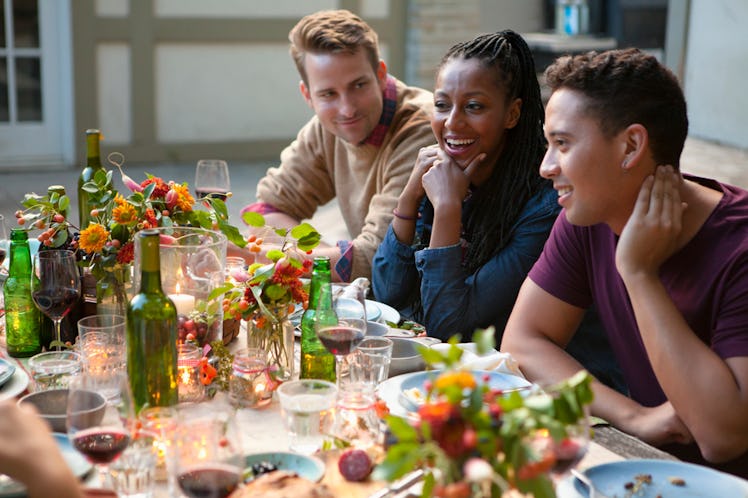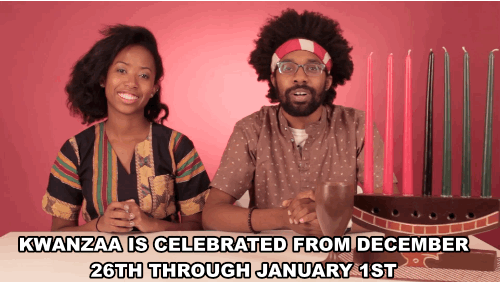
What To Expect From Your First Kwanzaa With Your Partner If You've Never Celebrated It Before
If you have never celebrated Kwanzaa before, you may not know much about it. Even if you learned about it in school years ago, maybe you don't know all of the history or the customs associated with the holiday. Either way, a refresher can't hurt. So whether you're in a fairly new relationship and are wondering how to celebrate Kwanzaa with your partner, or you just want to learn more about the holiday in general, this guide is for you. We'll start with the easy answers, like when the holiday takes place, and move into whether or not you need to get a gift, what you should expect each night, and more.
Christmas loves to steal the winter spotlight, and even Hanukkah gets its fair share of attention during this time of year. While Kwanzaa isn't actually a religious holiday, it's still an important celebration of African-American culture and community. Plus, it takes place in the same month as Christmas and Hanukkah, so if you haven't yet educated yourself, now is the ideal time to learn. This article will cover the basic traditions, as well as give a short history of the holiday. Did you know that learning new things is actually a big part of Kwanzaa? Well, now you do. See, we're off to a great start already.
When is Kwanzaa?

Kwanzaa is a week-long celebration that takes place from Dec. 26 to Jan. 1 each year.
What are the origins of Kwanzaa?
Kwanzaa is meant to honor African heritage in African-American culture. It was established in 1966 by Dr. Maulana Karenga, professor and chairman of Black Studies at California State University, Long Beach, according to History.com. The Black Freedom Movement was taking place, and Dr. Karenga wanted to help establish more of a community for African Americans. He combined aspects of different harvest celebrations to form the foundation for Kwanzaa. The name comes from the Swahili for "first fruits," which is translated as "matunda ya kwanza."
What are the seven principles of Kwanzaa?
Dr. Karenga also created the Nguzo Saba (which translates to "seven principles" in Swahili). These are values of African culture that contribute to maintaining a sense of community among African Americans. Each day of Kwanzaa is dedicated to one of the seven principles: Umoja (unity), Kujichagulia (self-determination), Ujima (collective work and responsibility), Ujamaa (cooperative economics), Nia (purpose), Kuumba (creativity), and Imani (faith). In addition to these principles, Kwanzaa also emphasizes seven symbols which represent cultural values and concepts.
What are the seven symbols of Kwanzaa?
The seven symbols of Kwanzaa are Mazao (the crops), Mkeka (place mat), Vibunzi (ear of corn), Mishumaa Saba (the seven candles), Kinara (the candleholder), Kikombe Cha Umoja (the unity cup), and Zawadi (gifts). The crops stand for work and symbolize the basis of the holiday. The place mat represents a foundation to stand and build upon. The corn represents fertility, the seven candles light, and the Kinara ancestry. The unity cup is used to perform a "Tambiko (libation) ritual" during the Karamu (feast) on the sixth day of Kwanzaa.
Meaningful gifts are given on the seventh day of Kwanzaa, mainly to children in the immediate family, as well as guests. Handmade gifts are encouraged, and presents should include a book and at least one of the seven symbols, according to Official Kwanzaa Website. The book emphasizes learning, and the symbol reinforces tradition and history.
How do most people celebrate Kwanzaa?
As with many holidays, every family celebrates a little differently, but celebrations often consist of songs and dances, African drums, storytelling, poetry reading, and the large traditional meal, or Karamu, held on Dec. 31, according to History.com. Each night, the family gathers for a candle-lighting ceremony. There are seven candles on the candle-holder called the Kinara — one for each of the seven principles
On the first night, a child lights the black candle in the center of the Kinara, and the principle umoja, or unity, is the topic of conversation. The next night, the red candle farthest to the left is also lit, and self-determination is discussed. Then, the green candle farthest to the right, then, the next red, and so on. The three candles to the left of the black candle are red, and the three to the right are green, incorporating the three colors of Kwanzaa.
Other decorations those celebrating Kwanzaa might use include items in these three colors, as well as traditional cultural items, such as African baskets, cloth patterns, art, and harvest symbols.
Is there a religious element to Kwanzaa?
Kwanzaa is a cultural holiday, not a religious one, according to Official Kwanzaa Website. On Kwanzaa, African American communities of all religious faiths come together to celebrate their shared culture and heritage. And many African Americans who celebrate Kwanzaa may also observe Christmas.
Whatever holiday(s) you celebrate, and however you choose to do so, I hope you enjoy!
Check out the entire Gen Why series and other videos on Facebook and the Bustle app across Apple TV, Roku, and Amazon Fire TV.
Check out the “Best of Elite Daily” stream in the Bustle App for more stories just like this!